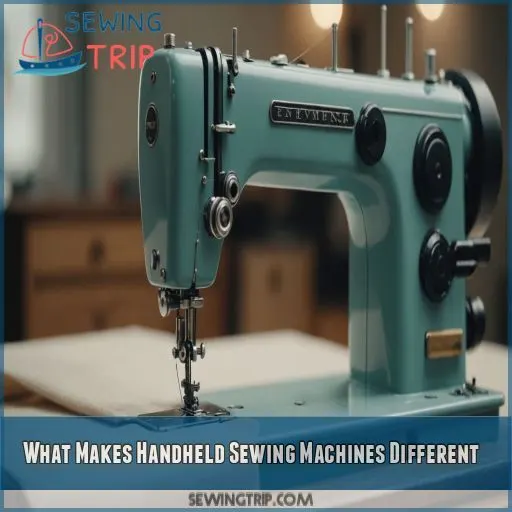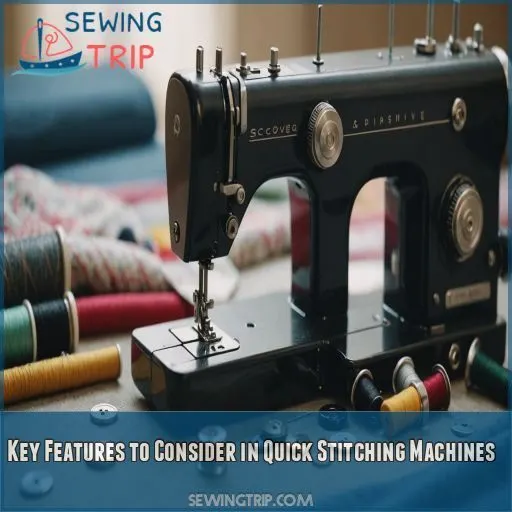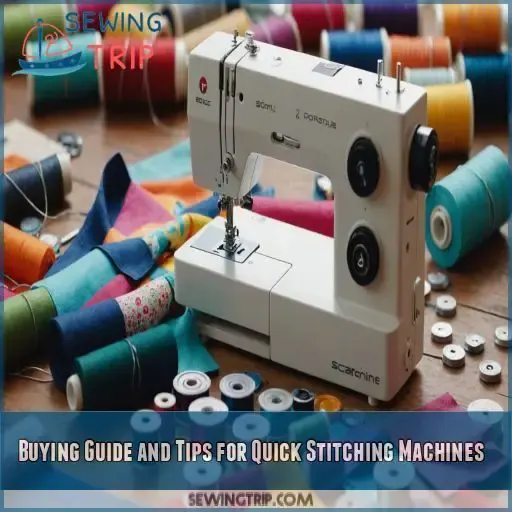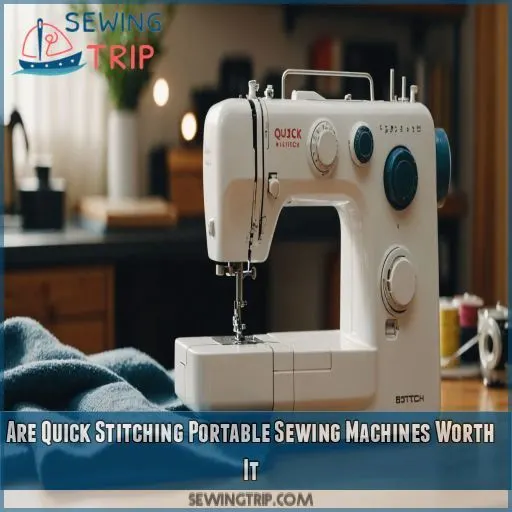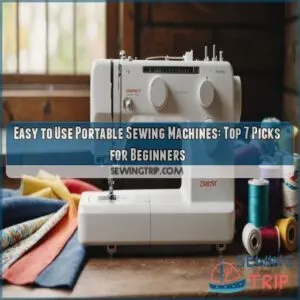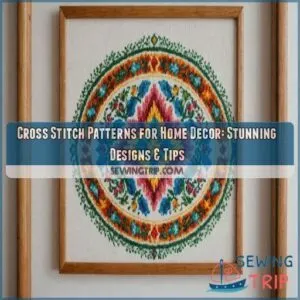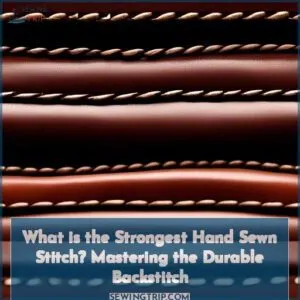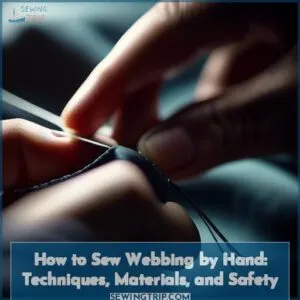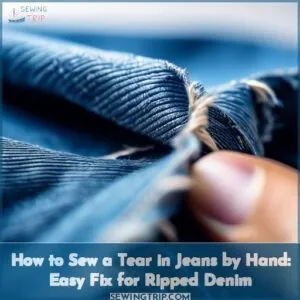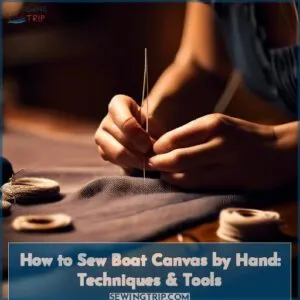This site is supported by our readers. We may earn a commission, at no cost to you, if you purchase through links.
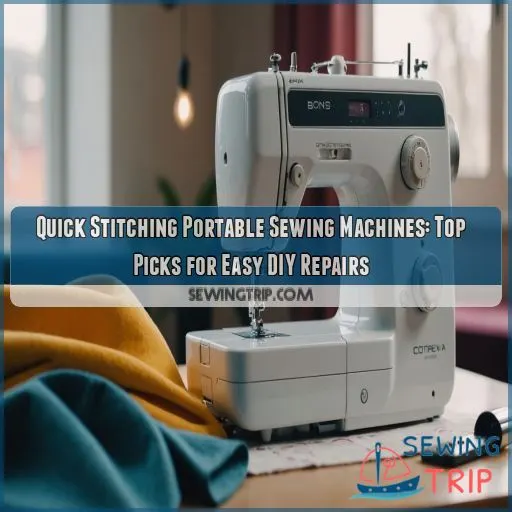
You’re not alone – these nifty devices are a game-changer for travelers, novice sewers, and seasoned pros alike.
With their compact size, battery-powered or manual operation, and affordable price tag (starting from under $20), it’s no wonder they’re a popular choice.
But what makes them tick?
Look for machines with easy-to-use controls, quality accessories, and a decent stitch variety.
We’ll explore the benefits, key features, and buying tips to help you find the perfect quick stitching portable sewing machine.
Table Of Contents
- Key Takeaways
- Benefits of Quick Stitching Portable Sewing Machines
- What Makes Handheld Sewing Machines Different
- Key Features to Consider in Quick Stitching Machines
- Buying Guide and Tips for Quick Stitching Machines
- Are Quick Stitching Portable Sewing Machines Worth It
- Frequently Asked Questions (FAQs)
- Conclusion
Key Takeaways
- You’re in luck if you’re looking for a convenient way to tackle small sewing projects or quick repairs on the go – quick-stitching portable sewing machines are perfect for DIY tasks, whether you’re a seasoned sewer or a novice looking for a hassle-free solution.
- When choosing a handheld sewing machine, consider the type of fabric you’ll be working with most often, and look for machines with adjustable tension and stitch length to avoid damaging delicate fabrics. Alternatively, opt for machines with metal frames and heavy-duty needles for heavier materials.
- Don’t expect handheld sewing machines to handle heavy-duty materials or complex tasks. They’re perfect for quick fixes, small DIY projects, and crafting on-the-go, but may struggle with thick fabrics or multiple layers. It’s essential to weigh the benefits and limitations before committing to a purchase.
- To get the most out of your handheld sewing benefits, look for machines with easy-to-use controls, quality accessories, and a decent stitch variety.
, look for machines with easy-to-use controls, quality accessories, and a decent stitch variety. Don’t forget to regularly clean and oil your machine to keep it running smoothly. With a little care and attention, your handheld sewing machine will be your new best friend for all your DIY sewing needs.
Benefits of Quick Stitching Portable Sewing Machines
You’re in luck if you’re looking for a convenient way to tackle small sewing projects or quick repairs on the go! With a quick stitching portable sewing machine, you’ll have the perfect tool for DIY tasks, whether you’re a seasoned sewer or a novice looking for a hassle-free solution.
Portability and Convenience for Quick Fixes
You’re always on the go, and so are your clothes – ripping, fraying, and coming undone at the worst times. That’s where handheld sewing machines come in, offering portability and convenience for quick fixes. With a portable stitching tool, you can tackle those pesky repairs anywhere, anytime, and get back to living your best life.
Ideal for Travelers and Small DIY Projects
You’re always on the go, and your sewing kit should be too! Handheld sewing machines are perfect for travelers and small DIY projects. Here are just a few reasons why:
- Travel sewing kits are a breeze with compact stitching machines TSA Travel Guidelines.
- DIY fashion is more accessible than ever with portable mending
- On-the-go crafts are easy with lightweight sewing machines
- Quick stitching is perfect for small, portable projects
Suitable for Novices and Seasoned Sewers
As a traveler or DIY enthusiast, you’ll love that handheld sewing machines are suitable for both novices and seasoned sewers. Whether you’re a beginner looking for easy sewing tips or a pro seeking new project ideas, these machines offer flexibility and ease of use. Here’s a quick comparison of machine options for different sewing levels:
| Sewing Level | Machine Options |
|---|---|
| Beginner | SINGER 01663, KPCB Tech Mini |
| Intermediate | SINGER Stitch Quick +, Sew Mighty Mini |
| Advanced | MICHLEY ZDML-2, SnowVoice Handheld |
| Expert | Nupec Handy Stitcher, Ankuwa Handheld |
Great for Working With Small Pieces of Fabric
The joy of working with small pieces of fabric! With a handheld sewing machine, you can easily create intricate designs, patchwork, and embroidery on mini projects like quilts, bags, or accessories. Perfect for fabric crafts, these machines give you the freedom to experiment and innovate on-the-go. Quick stitching has never been more accessible and fun!
What Makes Handheld Sewing Machines Different
You’re probably wondering what sets handheld sewing machines apart from their full-sized counterparts. Well, for starters, they’re smaller, lighter, and often powered by batteries or manual hand cranks, making them super portable and convenient for quick DIY repairs on the go.
Smaller and Lighter Than Full-Sized Machines
Now that we’ve covered the benefits of quick stitching portable sewing machines, let’s talk size. You’ll love that these mini sewing machines are remarkably smaller and lighter than their full-sized counterparts. Imagine being able to whip out a compact stitching tool from your travelers sewing kit to make a quick repair – it’s a total game-changer!
Powered by Batteries or Manual Hand Cranks
The freedom to sew anywhere! Handheld sewing machines offer two power source options: battery-operated or manual hand crank.
Battery life span varies, but most last several hours.
Manual operation is a breeze, and some machines feature one-hand operation and double-speed designs.
When choosing, remember to consider your needs and preferences, including battery life.
Always follow battery safety tips to guarantee a seamless sewing machine experience.
Generally Less Expensive Than Full-Sized Machines
Now that we’ve explored the power options, let’s talk turkey – or rather, the cost. Handheld sewing machines are generally less expensive than their full-sized counterparts. Here are three reasons why:
- Lower production costs: Fewer components mean lower production costs, which are then passed on to you.
- Smaller size, smaller price: Compact devices require less material, making them cheaper to manufacture.
- Budget-friendly brands: Brands like SINGER offer affordable options, like the Stitch Quick, without sacrificing quality.
Limitations and Suitability for Heavy-Duty Materials
You’re probably wondering what the catch is with handheld sewing machines. Well, here it is: they’re not suitable for heavy-duty materials. Think thick denim, canvas, or multiple layers of fabric – these machines just can’t handle it. They’re perfect for quick repairs and small projects, but don’t expect them to tackle heavy fabric with ease.
Key Features to Consider in Quick Stitching Machines
As you shop for a quick stitching portable sewing machine, you’ll want to think about the key features that’ll make your DIY repairs a breeze. From power source and portability to ease of use and durability, we’ll break down the essential factors to help you choose the perfect machine for your needs.
Power Source and Portability
In terms of power source and portability, you want a handheld sewing machine that’s as free-spirited as you are. Look for battery-operated machines with decent battery life expectations (around 4-6 hours). A cordless design benefits travelers, making it a travel bag essential. Some machines even come with portable storage cases and mobile power options.
Ease of Use and Intuitive Controls
Now that you’ve considered the power source and portability of your handheld sewing machine, think about how easy it’s to use. Look for simple operation steps, clear instruction manuals, and visual guides. An adaptive button layout and user-friendly interface will make sewing a breeze. A built-in thread cutter and safety switch are also convenient features worth thinking about.
Accessories and Durability
Now that you’ve got a handle on ease of use, let’s talk accessories and durability. A good handheld sewing machine should come with quality sewing needle care, a few bobbins, and some threads to get you started.
, a few bobbins, and some threads to get you started. Look for machines with protective cases to prevent damage. Remember, a well-maintained machine is key to mending hems and repairing tears on the go!
Basic Stitches and Variety for Flexibility
Now that you’ve got your accessories in check, let’s talk stitches! A good handheld sewing machine should offer basic stitches like straight and zigzag stitch techniques, plus some variety for flexibility.
, plus some variety for flexibility. Look for machines with adjustable stitch lengths and widths to handle different fabric types and thread options. This will give you the freedom to tackle various sewing techniques with confidence.
Buying Guide and Tips for Quick Stitching Machines
You’re ready to pick the perfect handheld sewing machine, but where do you start? Here, Here, you’ll learn how to make the right choice by considering the types of cotton fabric you’ll be working with, the features you need, and how to balance price with quality.
, the features you need, and how to balance price with quality.
Consider the Type of Fabric to Be Sewn
When choosing a handheld sewing machine, think about the type of fabric you’ll be working with most often. Here are some fabric considerations to keep in mind:
- Delicate fabrics: Look for machines with adjustable tension and stitch length to avoid damaging silk, cotton, or lace.
- Heavy-duty materials: Opt for machines with metal frames and heavy-duty needles.
- Fabric weight limits: Check the machine’s weight capacity to make sure it can handle thick fabrics like denim.
- Stretchy fabric issues: Consider machines with specialized stitches for knit fabrics.
- Specialty fabrics: Research machines designed for specific fabrics, like leather or vinyl.
Look for Machines With Additional Features
Now that you’ve considered the type of fabric to be sewn, it’s time to think about the extras that’ll make your handheld sewing machine a game-changer. Look for machines with built-in thread cutters, lights, and storage cases. Some models even come with interchangeable sewing needles and various bobbin types. These features will make your DIY projects a breeze!
Check the Price and Balance It With Quality
When shopping for a handheld sewing machine, price is a good starting point, but it’s not everything.
Look for budget-friendly options that offer value for money.
Balance price against features and quality materials.
Affordable sewing doesn’t have to mean sacrificing performance.
Weigh your needs against the cost, and you’ll find a machine that fits your budget.
Read Reviews and Product Descriptions
Now that you’ve got a handle on pricing, it’s time to hear from the people who’ve actually used these machines. Check out reviews from fellow DIY enthusiasts and read product descriptions carefully. Look for feedback on top-rated models, compare features, and weigh the pros and cons. This will give you a better sense of each machine’s strengths and weaknesses.
Are Quick Stitching Portable Sewing Machines Worth It
You’re probably wondering if quick stitching portable sewing machines are worth the investment.
After all, you don’t want to spend money on a gadget that’ll end up collecting dust.
As you weigh the benefits and limitations, consider whether the convenience, portability, and ease of use are worth the cost.
Whether trying one out before committing to a purchase is the way to go.
Weighing the Benefits and Limitations
As you weigh the benefits and limitations of quick stitching portable sewing machines, ask yourself: do the perks of travel-friendly DIY repairs and effortless mending outweigh the potential drawbacks? Consider your needs – if you value durability and convenience, these machines might be a game-changer. But, if you’re tackling heavy-duty projects, they mightn’t be the best fit.
Considering the Cost and Quality
Now that you’ve weighed the benefits and limitations, let’s talk turkey – or rather, the cost and quality of quick stitching portable sewing machines. Budget-friendly options abound, with prices ranging from under $20 to over $100. When evaluating value for money, consider the machine’s durability, stitch variety, and ease of use to make sure you’re getting quality that matches the price tag.
Trying One Out Before Committing to a Purchase
Ready to take the plunge and buy a handheld sewing machine? Before you commit, why not take one for a spin? Here are some ways to test drive your dream machine:
- Look for in-store trials or demo models to get a hands-on experience
- Check if local sewing studios or stores offer rental options
- Browse online marketplaces for test drive options or reviews from fellow crafty enthusiasts
Frequently Asked Questions (FAQs)
What type of sewing machine is the fastest?
You’re looking for speed! Handheld sewing machines like the Ankuwa or SINGER Stitch Quick + are your best bet, offering quick and efficient stitching for on-the-go repairs and small projects, giving you freedom to create anywhere!
Is there a sewing machine that is easy to thread?
You’re in luck! Many handheld sewing machines are designed with easy threading systems in mind.
. Look for models with clear threading paths, automatic needle threaders, or simple, intuitive controls that’ll have you sewing in no time!
What is the disadvantage of mini sewing machine?
The not-so-fun fact about mini sewing machines? They can be a bit of a letdown in handling heavy-duty materials – a major bummer if you’re working with thick fabrics or multiple layers!
Are hand held sewing machines any good?
You’re wondering if handheld sewing machines are any good? Honestly, they’re perfect for quick fixes, small DIY projects, and crafting on-the-go. Just don’t expect them to handle heavy-duty materials or complex tasks, and you’ll be golden!
Can handheld sewing machines be used for embroidery purposes?
You can use handheld sewing machines for embroidery, but with limitations. They’re perfect for small, intricate designs and quick repairs, but may not handle heavy-duty materials or complex stitches (Source).
How do I properly thread a handheld sewing machine?
You’ve got this! To thread a handheld sewing machine, start by loading the bobbin, then assemble the tensioner, and finally, thread the machine and sew (Source). Always refer to your machine’s manual for specific instructions .
Are handheld sewing machines suitable for sewing leather materials?
Let’s get real, friend – handheld sewing machines aren’t exactly leather-loving wizards. They can struggle with thick, tough materials, so it’s best to opt for a heavier-duty machine or manual stitching for your leather projects.
Can I use a handheld sewing machine for quilting projects?
You can use a handheld sewing machine for quilting, but keep in mind the project’s size and complexity. These machines excel at small-scale projects, repairs, and simple stitches, but may struggle with larger or more intricate quilts.
How do I maintain and clean a handheld sewing machine?
You’ll want to regularly clean and oil your handheld sewing machine to keep it running smoothly! Use a soft brush to remove lint and debris, and add a few drops of oil to moving parts every three months .
Conclusion
Are you ready to harness your creativity with a reliable sidekick?
Now that you’ve got the lowdown on quick stitching portable sewing machines, it’s time to find your perfect match.
With their compact size, easy-to-use controls, and affordable price tag, these nifty devices are a DIY dream come true.


